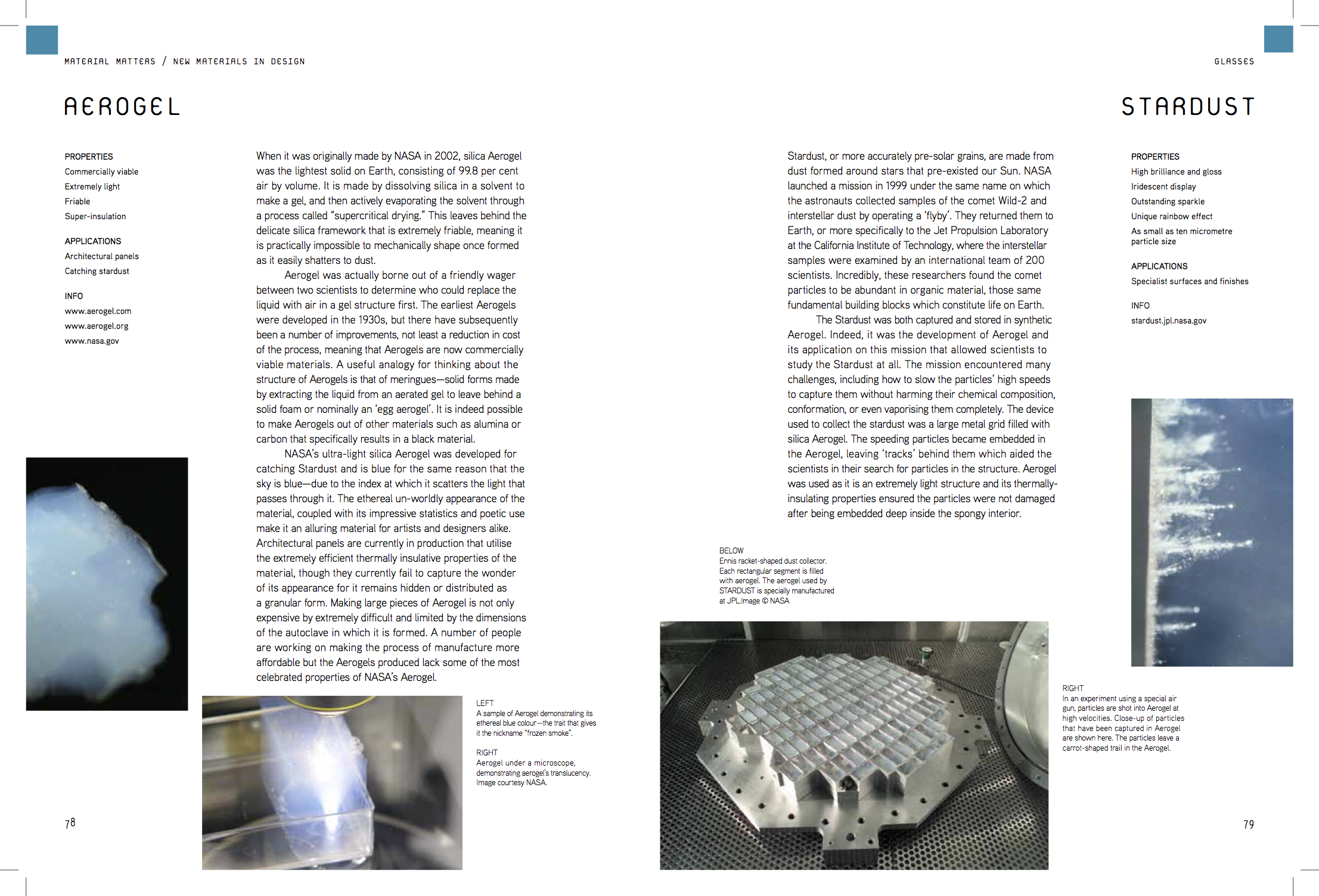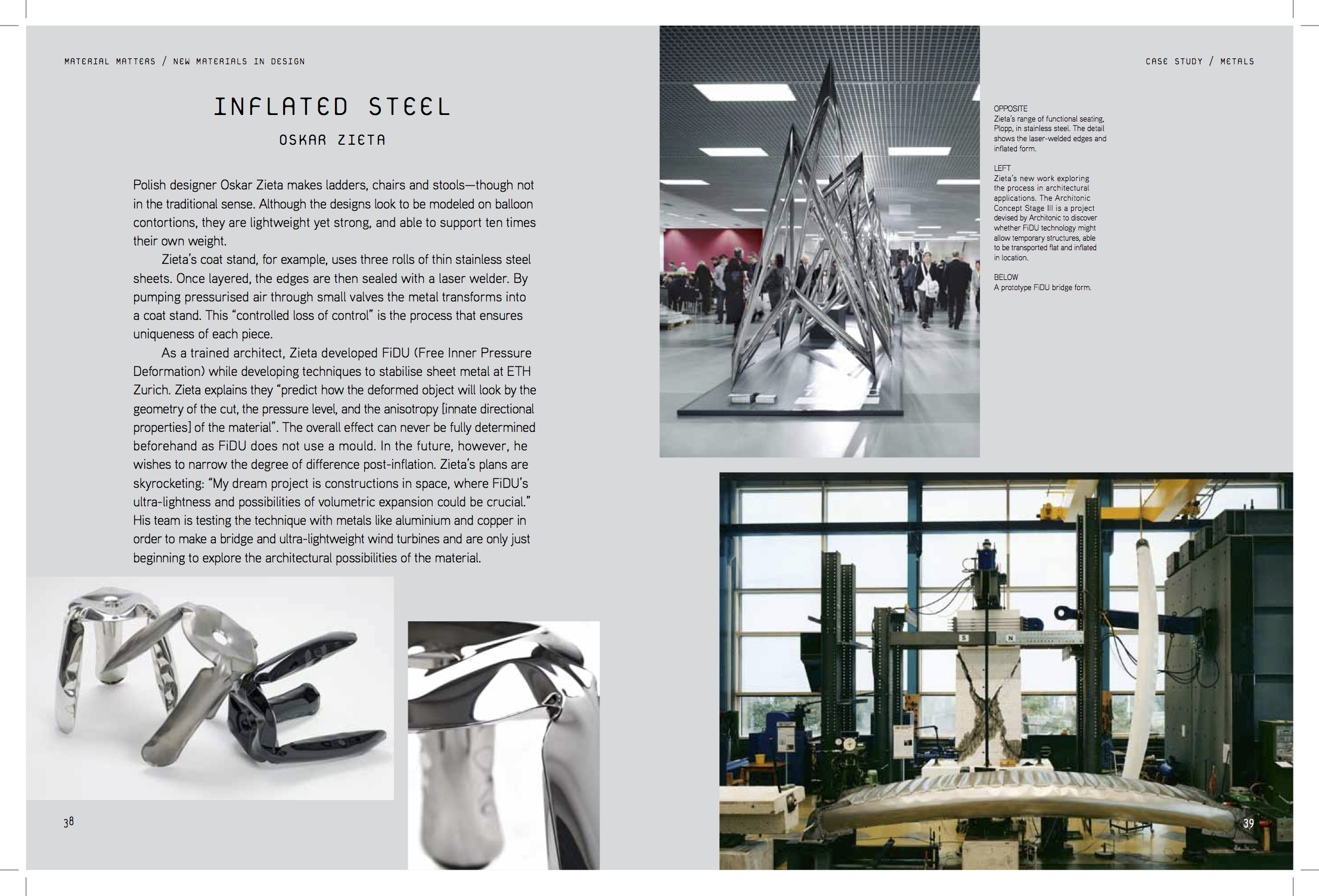Material Matters: New Materials in Design
(2012)
Zoe Laughlin and Philip Howes.
Black Dog Publishing, London, 2012.
ISBN: 978-1-907317-73-6





The Introduction
Materials matter. They are the stuff that constitutes everything around us; from mountains to mugs, everything is made from something. With such a broad defining remit, it is understandable that the question “what is a material?” is more commonly understood as “what are materials?”, with generations of scientists attempting to categorise and understand the fundamental nature of matter to answer this question. Given their all-encompassing scope, it is not surprising that materials are also the subjects of much examination by non-scientists. Practitioners from arts, craft and design disciplines each have specific materials expertise and interests that lead them to experiment with materials and engage in a multitude of making activities. Be it a potter who works with a selection of clays and strives to perfect a type of glassy glaze, a musician who coverts the specific tonally qualities of a particular wooden construction, or an artist who uses plastic detritus in great assemblages, materials are at the heart of many an artistic practice. The knowledge of how to manipulate materials to give specific forms or effects has historically been the property of the maker, passed down through generations and accumulating in cultures throughout globe. Be it methods to make beds, bread or buildings, the skills of masterful materials manipulation were practiced based. It was not until the invention of analytical technologies like microscopes that our understanding of what materials can be were informed by the internal reality of what materials are like. So successful were efforts to characterise and understand the behaviours of materials that the new found scientific knowledge of stuff now permeates much of our contemporary made world, therefore, for anyone engaged in a materials-based practice like design, a knowledge of the science of stuff is essential.
From a scientific perspective, the definition of a material starts at the smallest length scale, and works its way up from there. Although the wondrous scientific theories which describe the fundamental behaviour of matter are as intricate as they are complicated (quantum mechanics sets the stage here), it is possible for us to distil from them some simple and distinct concepts which underpin the character of all materials. We can start from the fact that all matter consists of atoms – as set out in the Periodic Table of Elements – consisting of nuclei containing protons and neutrons, orbited by electrons. The elements differ by size (larger atoms have larger nuclei and more electrons), starting from the lightest element, hydrogen, all the way up to the heaviest natural element uranium. The characters of the elements fluctuate wildly as we ascend this list, ranging from stable and solitary elements like neon, to unstable and erratic ones like francium. In the natural world, however, very few of the elements exist in a pure state, which brings us to the second concept: the way atoms bind with one another. Atoms naturally arrange themselves into molecules, ranging from tiny to (relatively) massive, or into larger structures like crystals. The nature of such constructions is dependent on the strength and character of the binding between atoms, the way they are arranged, and the environment in which they find themselves. Finally, to obtain a solid material, these atomic constructions need to tightly bind together into a structure. If this binding is not very strong, the material will be a liquid, or if it is very weak, it will be a gas. An excellent example is water, a material with which we are familiar in all its states, from steam to ice. When the water molecules have lots of energy, as in steam, they move around barely even noticing each others’ presence. However, as they lose energy and become slower, they begin to feel the attraction of their neighbouring molecules, forming liquid water. If they lose even more energy, the attraction between them becomes irresistible and they bind together to form ice. Overall, a point worth remembering is that the macroscopic properties of a material can always be traced back to the goings on at the microscopic level. Furthermore, a little understanding of what is going on down at this level will allow you to really understand and appreciate the wondrous nature of materials.
In order to characterise materials, it is necessary to define both composition (the types of atoms) and structure (how they are arranged). Materials scientists study material structure at different length scales and relate it to the material’s overall characteristics. This multi-scale structure is present in all materials, including biomaterials with which we are maybe more familiar (DNA, in a cell nucleus, in a cell, in a tissue, in an organ, in a body etc). The structure at all scales influences properties like elasticity, conductivity or strength, and it is a central tenet of materials science that a particular structure will always yield a particular set of properties. With a thought for materials engineering and design, it follows that the control of structure allows the control of material properties. This is of fundamental importance in materials: the better our understanding of, and control over, the microscopic world of materials, the greater is our ability to engineer materials in the macroscopic world.
After a particular material has been characterised by materials science, the data obtained becomes a source of information for those who need to choose a material with specific properties for a specific application. This is an extremely refined process, and it is now very well understood how specific physical properties relate to their overall behaviour. This means that there is a huge amount of technical materials information available scientists, technologists and industrialists, who use it to inform their decisions. However, this information is almost exclusively about the mechanical physicality of materials, properties like strength, ductility or hardness, and as such sheds very little light on an often understudied side of materials: their more sensorial aesthetic properties.
Within the world of materials practitioners, there exists a common division between the materials science community, those scientists, technologists and industrialists who are interested in the physicality of materials, and those in the materials-arts community who are interested in the sensorial and aesthetic properties, and our perception of them. Although both sides possess a huge amount of excellent materials knowledge, they often do not speak a common language. Some excellent designers have developed outstanding working relationships with engineers, but these collaborations are not embedded in the education of either party as part and parcel of what is required to fully understand and use materials in the world, through acts of making. However, we anticipate that people working at the interface of these two sides can alleviate this situation. By using scientific methods to study those properties of materials that are largely ignored by the materials science community yet are vitally important to the likes of industrial designers, architects, artisans and artists, it will be possible to develop a sensoaesthetic theory of materials that will act to bridge the science–arts materials divide. As the experience of the sensual and aesthetic side of materials is a matter of perception, a large part of this work falls within the realm of psychology. Hence, development here will require a strong fusion of materials science, a discipline driven by physical characterisation, and psychophysics, the science of perception.
Upon first consideration it may seem that a formal quantitative scientific discipline would not shed much light on the more experiential, qualitative and perceptual side of materials. However, upon closer inspection it becomes obvious that the way we interact with, and the resultant experience we gain from, all materials is rooted in their fundamental physical properties. Our advanced and highly sophisticated sense of materiality is something we take for granted. Each of us has a huge amount of materials knowledge that we use in all of our interactions with the physical world, and it is perpetually being updated. Our minds are like databases of sensory experiences, such that when we come into contact with a material the brain retrieves and pieces together the relevant information to interpret what is happening. Our sense of touch alone tells us a great deal of materials information. When touching a material, the dominant factors that we use to identify it are roughness, warmth and hardness. If we touch something that feels hard and cold, we expect it to be something like metal, glass or stone. If we add to this the surface texture, then we are more than likely going to be able to identify exactly what type of material it is. However, this example only considers touch in isolation and is therefore only the tip of the iceberg of how we use our sense to identify and form perceptions of materials in real world situations. When we use all of our sense in combination, we have some really powerful tools for materials investigation. Through our senses of touch, taste, smell, hearing and vision we can amass a huge amount of accurate information about a material very quickly.
So, where does materials science come into the equation? Well, all of our senses are actually detecting the physical properties of a material, and it is those physical properties which materials science sets out to investigate and characterise. For example, metals will generally feel cool to the touch because they conduct heat away from the skin very quickly. So we can say that, in general, materials with high thermal conductivity will feel cool to the touch. If an object is soft to the touch, then we can look at physical variables such as elastic modulus or plasticity to characterise the interaction. Thus it becomes apparent that our sensual and aesthetic interaction with, and appreciation of, materials is rooted in their physicality, and we can unravel these perceptual experiences using scientific methodologies.
We have considered what materials are from a scientific perspective, and we have thought about how our sensory appreciation of materials is dependent upon physical material properties. However, such an academic discussion of materiality really misses out a key point: materials are for making, they are the stuff of things. The practical application of materials is what brings them alive: it is what turns plastic into prosthetic limbs, stone into sculpture, and metal into machinery. The materials in this book are presented within the traditional categories of science: metals, glasses, ceramics, polymers and composites, plus a chapter on materials futures. They are all, in their own right, incredible: stretching from the seemingly familiar to the sublimely sophisticated. However, going beyond these categorised materials into the design and making phase is what really turns them from standalone curiosities into revolutionary new ideas, objects and products. And it is in this step where the makers come to the fore, where tools are used to transform matter, and to create masterpieces.
Zoe Laughlin and Philip Howes, 2012.

